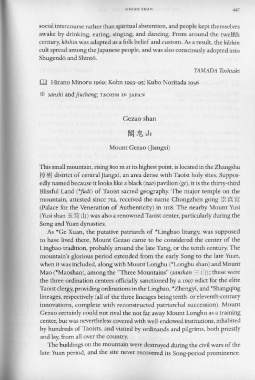Page 487 - The Encyclopedia of Taoism v1_A-L
P. 487
GEZAO SHAN 447
social intercourse rather than spiritual abstention, and people kept themselves
awake by drinking, eating, singing, and dancing. From around the twelfth
century, koshin was adapted as a folk belief and custom. As a result, the koshin
cult spread among the Japanese people, and was also consciously adopted into
Shugendo and Shint6.
YAMADA Toshiaki
m Hirano Minoru 1969; Kohn 1993-95; Kubo Noritada 1956
* sanshi andjiuchong; TAOISM IN J APAN
Gezao shan
Mount Gezao (Jiangxi)
This small mountain, rising 800 m at its highest point, is located in the Zhangshu
f~ W district of central Jiangxi, an area dense with Taoist holy sites. Suppos-
edly named because it looks like a black (zao) pavilion (ge), it is the thirty-third
Blissful Land (*fudi) of Taoist sacred geography. The major temple on the
mountain, attested since 712, received the name Chongzhen gong *' ~ '§
(Palace for the Veneration of Authenticity) in l ll8. The nearby Mount Yusi
(Yusi shan 3I. ~ ill ) was also a renowned Taoist center, particularly during the
Song and Yuan dynasties.
As *Ge Xuan, the putative patriarch of *Lingbao liturgy, was supposed
to have lived there, Mount Gezao came to be considered the center of the
Lingbao tradition, probably around the late Tang, or the tenth century. The
mountain's glorious period extended from the early Song to the late Yuan,
when it was included, along with Mount Longhu (*Longhu shan) and Mount
Mao (*Maoshan), among the "Three Mountains" (sanshan = ill); these were
the three ordination centers officially sanctioned by a 1097 edict for the elite
Taoist clergy, providing ordinations in the Lingbao, *Zhengyi, and *Shangqing
lineages, respectively (all of the three lineages being tenth- or eleventh-century
innovations, complete with reconstructed patriarchal succession). Mount
Gezao certainly could not rival the not far away Mount Longhu as a training
center, but was nevertheless covered with well-endowed institutions, inhabited
by hundreds of Taoists, and visited by ordinands and pilgrims, both priestly
and lay, from all over the country.
The buildings on the mountain were destroyed during the civil wars of the
late Yuan period, and the site never recovered its Song-period prominence.

